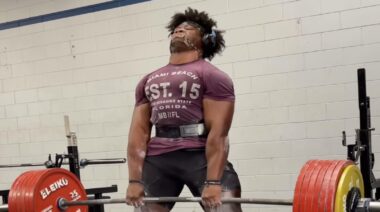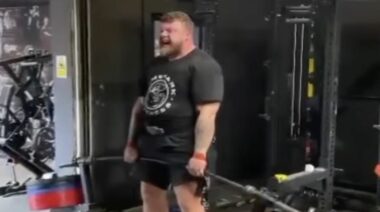The following in an excerpt from Andy Bolton’s book “Deadlift Dynamite“:
I deadlift using the conventional style.
I tried sumo once and quickly found I severely lacked the inner thigh mobility to pull off this style with any kind of professionalism. For the record, I think I checked out with around 350kg for a single. At the time my conventional was over 440kg, so as you can see, the sumo wasn’t the style for me.
As is the case for all good pullers, my deadlift style is the product of my levers, my particular strengths, and a lot of hard work!
What this means is that I pull without a great deal of bend in the knees, with very vertical shins and with an arched lower back. I believe that my pull is a fairly equal combination of leg drive, lower back, and upper back strength. However, the truth of the matter is that I have no way to prove this without going to a ‘lab’ and having a scientist see how much force all my muscles are generating at different times during my deadlift.
The bottom line is that my technique works perfectly for me and provides maximum strength and minimum injury-risk.
NOTE: For anyone thinking of pulling with a rounded lower back or even a very rounded upper back: your injury-risk will be much higher than if you chose to use a style more like my own.
Let’s take a more detailed look at my deadlift technique:
I address the bar with a hip width stance, shins touching the bar.
Then I bend down and set my hands on the bar; as I do this I bend my legs only enough to grasp the bar. Remember, this is a deadlift not a squat!
This next point is very important: when I set my hands on the bar I use a mixed grip and make sure that my arms are hanging straight down from my shoulders. If I was to take my arms out and away from my shins I’d be turning the pull into more of a snatch grip deadlift. With max weights this would make a bicep tear likely and would significantly reduce the amount of weight I could lift.
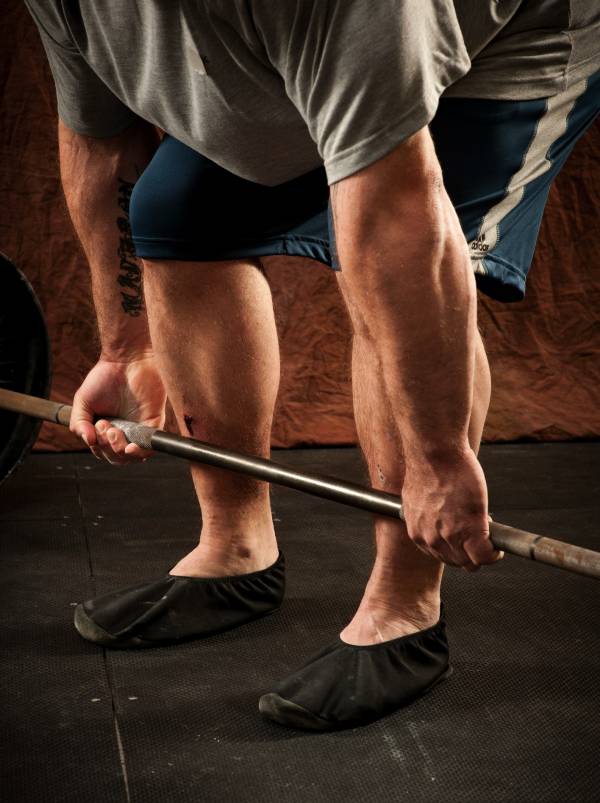 To re-cap:
To re-cap:
- Hip width stance
- Shins touch the bar
- Arms hang straight down from the shoulders and take a mixed grip on the bar
Another point you should be aware of is with regards to my head position. My neutral head position means that I am looking at a spot on the floor about 6 to 8 feet in front of me when I am in the start position of my pull. I don’t listen to all those dudes saying, “Look up, look up!”
What I do next is allow my hips to rise and then forcefully pull them back down so that my shins touch the bar. I do this again and then I do it a third time.
On the third go, I pull. Be aware that as I pull my scapulae are directly over the bar – this is essential for a strong deadlift.
What you need to understand is that each time I pull my hips down into the bar I am generating more force. In other words, I don’t go from relaxed to generating over 1,000lbs of force in a split second. Instead, I allow the force to build over the course of a second or two, using these three ‘dips.’
NOTE: That’s why you see the bar bending before I pull it.
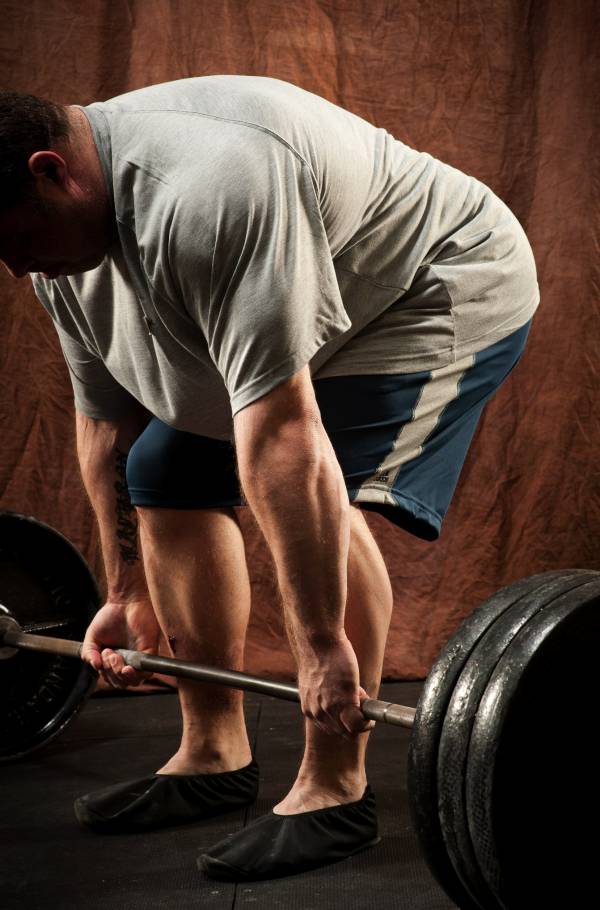 When the bar leaves the floor, my abs and lats are as tight as I can possibly get them. The abs are braced – imagine what you would do if you were about to get punched in the stomach to absorb the force and you will understand the meaning of ‘braced.’
When the bar leaves the floor, my abs and lats are as tight as I can possibly get them. The abs are braced – imagine what you would do if you were about to get punched in the stomach to absorb the force and you will understand the meaning of ‘braced.’
Most average lifters ‘get’ the concept of bracing the abs fairly quickly, but many struggle with getting their lats tight. This tightness of the lats and abs is what enables me to keep my lower back in a good position throughout the pull, while also preventing any ‘strength leakages.’
To get the feeling of locking your lats, set-up in your regular deadlift stance. Now have your training partner karate chop you in the lats five times. Providing you are alive, you will soon learn to tense your lats! Once you understand how to tense your lats, lock them at the start of the pull and keep them like that throughout.
Now, back to my pull…
As the bar leaves the floor, I keep it very close – that’s why all great deadlifters have scars on their shins. Letting the bar drift away from your shins and out in front of you is a great way to fail a big deadlift attempt. For every centimeter you allow it to get in front of you, the weight feels much heavier and greatly stresses the lower back.
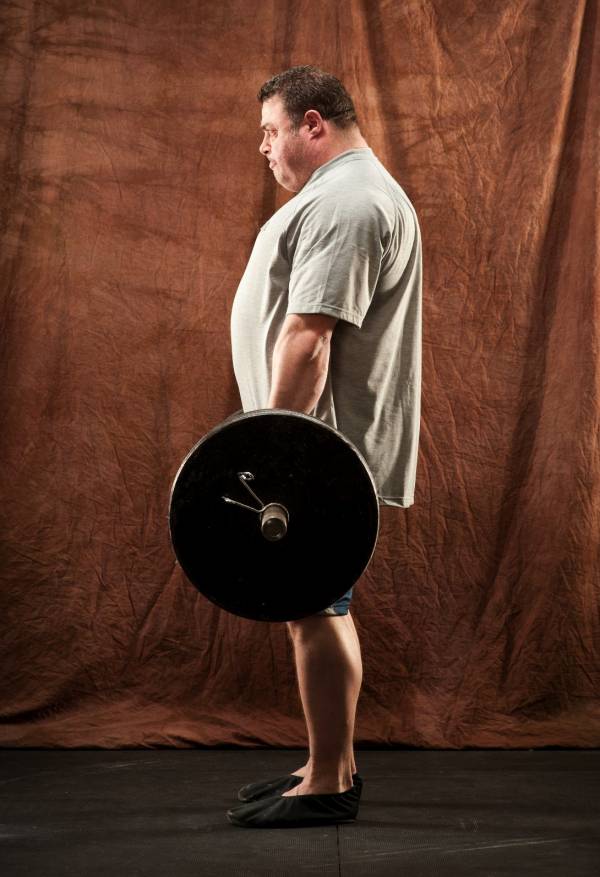 So the bar must stay close.
So the bar must stay close.
As I lift the bar higher and higher off the ground I carry on squeezing my grip as hard as possible. As the bar passes my knees I drive the hips forward to lockout the weight.
At lockout I stand tall, chest out, shoulders back and down.
I do not hyperextend at lockout – always the tell-tale sign of an inexperienced puller or simply a masochist who enjoys hurting his or her lower back!
Once locked out I usually do some immature, fancy stuff like sticking my tongue out and looking at the crowd, but you don’t need to this.
All that’s then left is to stay tight, push the hips back and lower the bar to the floor.
Let’s summarize my deadlift technique:
- Set-up with a hip width stance, shins touching the bar, toes turned slightly out.
- Letting my arms hang down from my shoulders, I take a mixed grip on the bar.
- I now let my hips rise and do 3 ‘dips’ into the bar.
- On the third dip, I pull.
- My abs are braced and my lats are locked.
- As I pull, the bar stays close to my body at all times.
- As the bar clears my knees I drive my hips through to lockout.
- At lockout I stand tall but don’t hyperextend.
That’s it – that’s how I deadlift.
One final point: you’ll notice that my hips and back lockout at the same time.
For many lifters their legs are locked out a long time before the pull is completed, leaving their backs to finish the pull.
I believe this increases injury-risk for the back.
Train with Andy Bolton – Click here for his free strength training program.
Curious about the rest of the book? Read our book review.
“Deadlift Dynamite” is available for $49.95 at DragonDoor.com.


